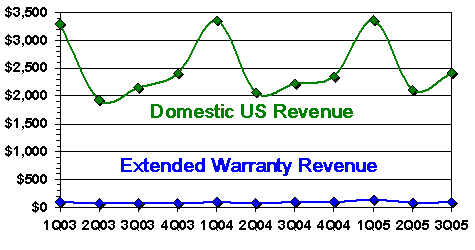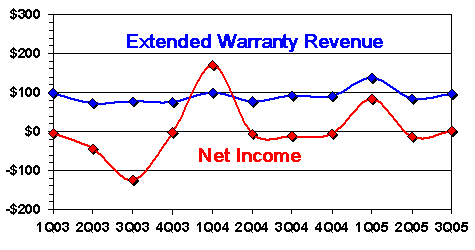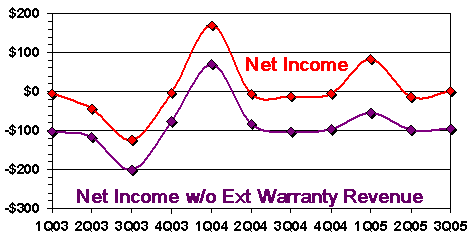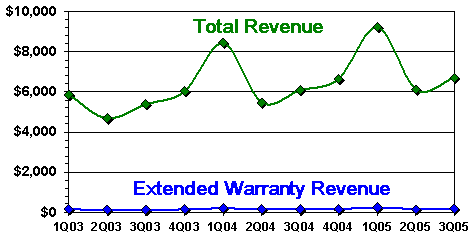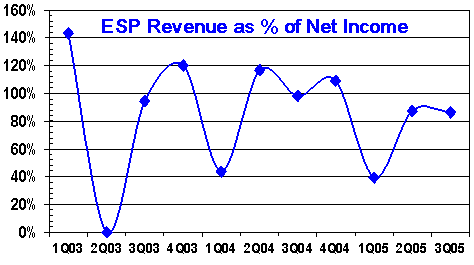November 1, 2005 |

|
ISSN 1550-9214 |
Extended Warranties:Now that Wal-Mart has finally jumped into the business, let's take a detailed look at how this seemingly minor source of revenue is in fact a major source of many retailers' profits.When Wal-Mart Stores Inc. announced its intent last week to begin selling extended warranties on TVs and computers priced over $300, some people began to wail like it was the end of the world. The world's largest retailer, they feared, was about to become the world's largest extended warranty sales agent, at the expense of Circuit City Stores Inc., Best Buy Inc., Sears/Kmart, and others. Wal-Mart's claims administrator will be N.E.W. Customer Service Companies Inc., a sponsor of this newsletter, and its underwriter will be AIG Warranty Guard Inc. These are the same pair of companies who have already partnered to run Best Buy's extended warranty program, as well as the program at Kmart Holdings Corp. With Aon Warranty Group as its underwriter, N.E.W. also had been administering the extended warranty program at Sam's Club, the $31 billion "members only" division of Wal-Mart aimed at small businesses. So its is eminently qualified to take on such a potentially huge account as this. Skills such as the ability to train sales staff and more basically, to answer phones and process claims, are in abundance at N.E.W. More importantly, N.E.W. keeps its own database of product failures and employs a full-time actuary to ensure that its contracts are priced appropriately. From N.E.W.'s point of view, everything it needs to allow Wal-Mart to become a successful extended warranty retailer is in place. But Can They Sell?From Wal-Mart's point of view, however, there are still a few missing pieces to the puzzle. First and foremost, does the average Wal-Mart associate have the skills and training required to sell a product and then sell an extended warranty? These things don't sell themselves. Just ask any online retailer who uses clickable yes/no radio buttons on a Web page instead of a well-trained salesperson to sell extended warranties. It's just too easy to say no, and even on a good day, well over half the buyers will indeed say no. To successfully sell an extended warranty, the sales associate must first tout the features and benefits of the product in order to close the sale of the actual box. Then, without scaring off the buyer, they must pivot in place so they can thrill the buyer with tales of technology gone awry, or repair costs spiraling out of control. The only way the buyer will be able to sleep at night? Why, all they need to do to ensure their peace of mind is purchase an extended warranty, or in Wal-Mart's terminology, a Product Care Plan. Wal-Mart's 1.6 million "associates" are well-known for their friendliness, but are they really going to be able to finesse the sale of an extended warranty? And if they can't, then who will? The cashier? Meanwhile, Wal-Mart's customers are well-known for their ability to find a bargain. That's why they go there, because of Wal-Mart's everyday low prices. But are these really the kind of shoppers who can be convinced to pay an extra 10% or 15% for the sake of their peace of mind? A while back, extended warranty sales revenue dropped at Circuit City, and the company blamed the dip on its reliance during the holiday selling season on new and untrained temporary staff. These holiday temps were competent, helpful, and eager, but they just weren't the type of employees who could execute that perfect pirouette, turning from selling the unit to selling the insurance for the unit. We'd suggest Wal-Mart's upcoming holiday season will be filled with stories like this, where it was just too easy for the customer to say no to the extended warranty sales pitch, if they even get to hear it. World's Largest RetailerOf course, Wal-Mart is still the world's largest retailer. In the fiscal year ended Jan. 31, Wal-Mart reported revenue of $285.2 billion, and net income of $10.27 billion. Meanwhile, Sears Roebuck reported $36 billion in revenue and a $507 million net loss. Kmart reported revenue of $19.7 billion and $1.1 billion in net income. Best Buy reported $27.4 billion in revenue and $984 million in net income. Circuit City reported revenue of $10.47 billion and net income of $60 million. Suffice it to say that Wal-Mart is larger than all of them put together. However, Wal-Mart is probably not the world's largest electronics retailer (at least not yet). That title is still probably held by Best Buy, because only 8% or 9% of Wal-Mart's and Sam's Club total revenue is likely to be classifiable as consumer electronics. And as profitable as apparel or food may be, they're usually not warranted products. So really, in terms of extended warranties, Wal-Mart has about as much of a potential market as Best Buy. It's incredible that Wal-Mart waited until 2005 to begin experimenting with the sale of extended warranties, and that it waited until late October to make it official. Very few major retailers don't sell either their own or some third party's extended warranties (tops on the list now? Costco and Walgreen's). Furthermore, the Sam's Club unit has been selling extended warranties for 14 years, which makes the delay all the more curious: it's not as if they were unfamiliar with the lucrative economics of extended warranty sales. Rumor is that the founders of Wal-Mart thought extended warranties did not represent a good value to the consumer. How to make them a good value, then? Sell them at low markups, which is exactly what Wal-Mart seems to now be doing. For a circa $1600 plasma TV, Wal-Mart's service contracts are $149, Circuit City is $260, and Best Buy is $400. For a circa $1600 Toshiba laptop, Wal-Mart's service contracts are $103, Circuit City is $265, and Best Buy is $300. There are some differences in the plans, but the most obvious difference is in their price. It could be that Wal-Mart doesn't really anticipate selling very many service contracts, because their sales associates won't push them too hard. However, if a potential buyer comes through the door looking for a laptop or a plasma screen covered by an extended warranty, at least now Wal-Mart won't have to tell them to shop elsewhere. They've eliminated a negative, and they've done so in a way that passes on the value to their customers: foresaking much of their own potentially significant sales commissions. When Best Buy or Circuit City sell an extended warranty, they immediately take their cut as a sales commission and pass the remainder onto their administrator. Warranty Week estimates that the full retail value of the extended warranties sold by Best Buy is in the neighborhood of $1.3 billion per year, and is $800 million at Circuit City. We don't know precisely what share of the total is kept by these retailers as sales commissions, but let's assume it's close to 50%. That would suggest Best Buy's extended warranty sales commissions are close to $650 million per year, and Circuit City's are close to $400 million per year. Not Much Revenue?In percentage terms, that means extended warranties are a paltry 2.4% of total revenue for Best Buy, and only 3.8% of Circuit City's domestic U.S. sales revenue. One could wonder what's the big fuss, then. However, that misses the real point, which is the profitability of this little sliver of the pie. What we're going to do is take you through a series of six charts which will lead you to the conclusion that extended warranty revenue typically exceeds net income for these two companies. First, let's start with what we know for certain. In each Form 10-Q or 10-K financial statement, Circuit City usually reports either the percentage of revenue that comes from extended warranties, or the dollar amount, or both. And of course it always reports its total revenue and net income (or loss). For the past 11 quarters, the share of Circuit City's total domestic U.S. sales revenue attributable to extended warranty sales commissions has varied from $72 to $138 million per quarter, and from 3.0% to 4.1% of sales, as the chart below illustrates. Figure 1 | |||||||||||||||||||||||||||||||||||||||||||||||||||||||||||||||||||||||||||||||||||||||
| |||||||||||||||||||||||||||||||||||||||||||||||||||||||||||||||||||||||||||||||||||||||


